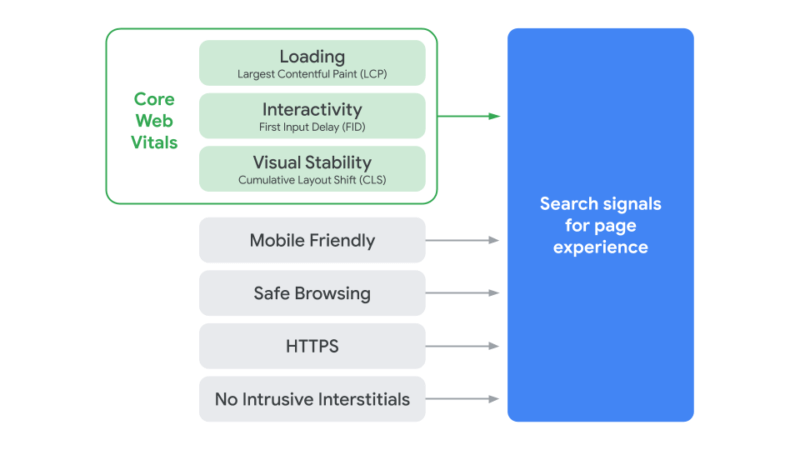SEO
Google Page Experience to Redefine SEO in 2021
Back when internet search engines were shiny and new, Search Engine Optimization (SEO) was wild and wooly. Overzealous web designers could shove 10 pounds of keywords into the 5-pound sack that was their website and trick dum-dum search bots into higher rankings. It didn’t matter that the alphabet soup mish-mash of crammed-in keywords made the pages nigh-on unreadable. The bots ate it up and spat out top rankings on Search Engine Results Pages (SERPs).
SEO has changed dramatically since then.
Modern search engines, especially Google (which dominates with 92.06% of the worldwide search engine market), are far from dumb. Designers can no longer trick the system. Google assesses every website for several qualities, including keywords, readability, longevity, backlinks, and an amorphous value known as “authority.” Trying to use cheap tricks to boost SEO at the detriment to readability will actually penalize the offending site and cause it to rank even lower on the SERP.
Well-crafted content won out over keyword stuffing, and we all lived happily ever after, right?
Not for long.
TL;DR: Your website needs a facelift to remain competitive.
Google Page Experience Update
On May 28, 2020, Google announced an update to its website-ranking algorithms. The Google Page Experience update is set to roll out sometime in 2021, with significant changes to how the Google search algorithms assess and rank websites. Once the update rolls out, websites will need to pass muster on an additional set of classifications, based on the user’s visual experience — and level of frustration.
In addition to the SEO factors listed above, Google will now rank websites on:
- Page-load speed
- Security
- Mobile-friendliness
- Intrusive pop-up or embedded ads
- Visual stability during page loads
Core Web Vitals
Essential to this new ranking scheme are three attributes known as Core Web Vitals. Each ranking carries different weight when it comes to influencing organic search engine results.
Here is what Google has to say about the Core Web Vitals (information licensed under Creative Commons Attribution 4.0):
- Largest Contentful Paint (LCP): Measures loading performance. To provide a good user experience, sites should strive to have LCP occur within the first 2.5 seconds of the page starting to load.
- First Input Delay (FID): Measures interactivity. To provide a good user experience, sites should strive to have an FID of less than 100 milliseconds.
- Cumulative Layout Shift (CLS): Measures visual stability. To provide a good user experience, sites should strive to have a CLS score of less than 0.1.
(image courtesy of Google, LLC)
Accompanying the Core Web Vital ratings are assessments on the following aspects of the website. Again, definitions provided by Google under Creative Commons Licensure:
Mobile-friendly
The page is mobile-friendly. Check if your page is mobile-friendly with the Mobile-Friendly Test.
Safe-browsing
The page doesn’t contain malicious (for example, malware) or deceptive (for example, social engineering) content. Check to see if your site has any safe-browsing issues with the Security Issues report.
HTTPS
The page is served over HTTPS. Check if your site’s connection is secure. If the page isn’t served over HTTPS, learn how to secure your site with HTTPS.
No intrusive interstitials
The content on the page is easily accessible to the user. Learn how interstitials can make content less accessible.
And here is how all of the Google Page Experience factors stack up to determine the SERP placement of a website:
(Image courtesy of Google, LLC)
While all of the above factors (in addition to existing SEO standards) affect page ranking, the Core Web Vitals are, well, vital.
So What Does This Mean to Me?
What all of those links, definitions, bullets, and charts are trying to say is that no matter how well-written your website SEO may be, changes are a-coming. Soon, User Experience (UX) will play a massive role in how your website ranks.
Luckily, there’s still time to act.
Google set the roll-out for the Google Page Experience update as “sometime in 2021.” That means you have at least 6 months to update your site’s usability to match Google’s best practices. And that’s where AMMO comes in. Contact us today for help assessing the user-friendliness and SEO-soundness of your current site. We’ll see how it stacks up to the new Core Web Vitals test.
If it needs some help getting there, well, you’ve come to the right place. Our portfolio may speak for itself, but that doesn’t mean we don’t love talking with you about helping your website succeed.
More AMMObservations


